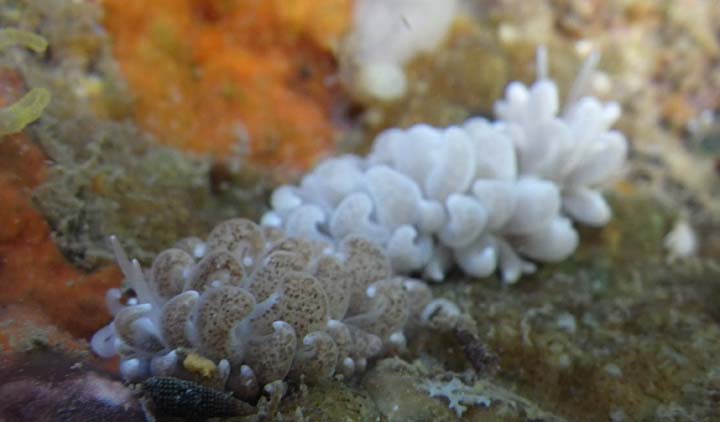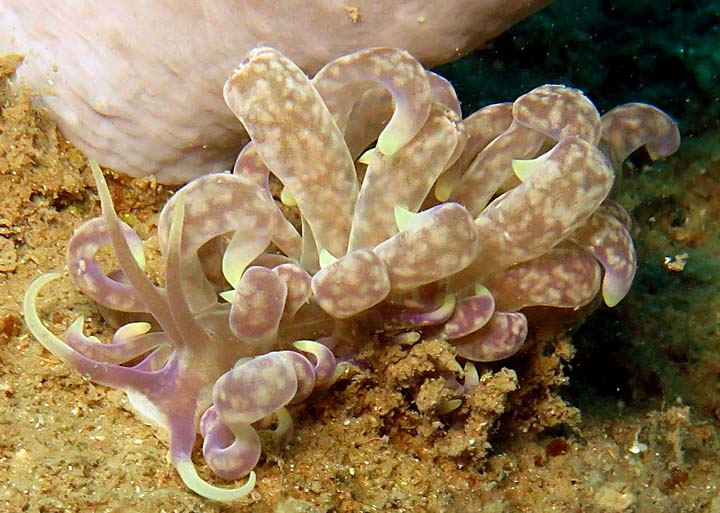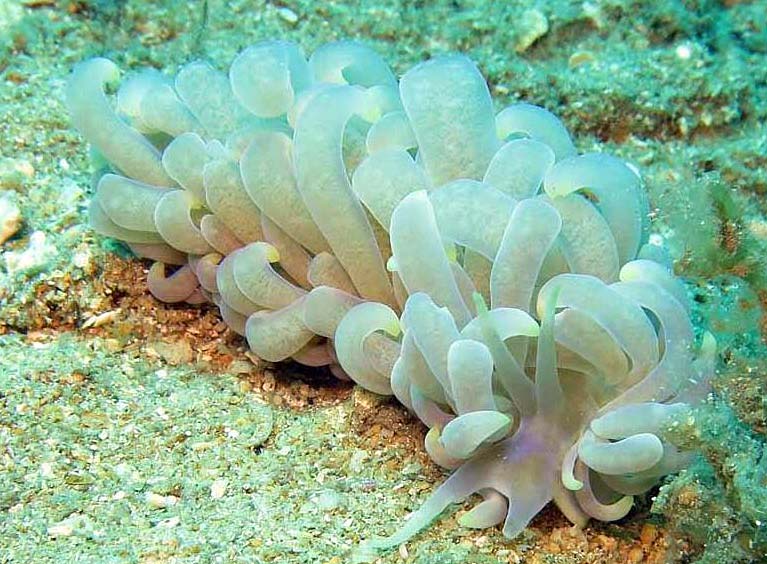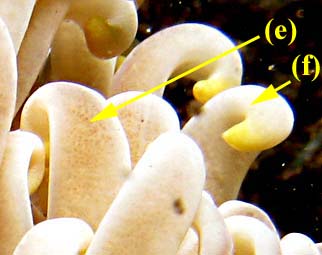This species has been observed on Reunion Mayotte, Madagascar and Seychelles Islands
The body wall is a dull translucent white but embedded in it are countless microscopic brownish zooxanthellae which give it and the dorsal side of the cerata a brownish tinge. The purplish tinge to the skin, the yellow tipped rhinophores, oral tentacles and cerata, and yellow border to the foot are all characteristic of that species. The cerata are large, flattened, and partially coiled cerata, with a short cylindrical base and a bluntly pointed tip. |

|
|
| Showing species characteristics... | Photo Sully Bachel |
|
See more about : Sightening and mating periods
See more about : Phyllodesmium phylogeny by Moore & Gosliner, 2009
See more about : Phyllodesmium ceratal arrangement by Rudman, 1991
See more about : Ceratal structure in Phyllodesmium by Rudman, 1991
Remarks :
Identification confirmed by Nathalie Yonow
Synonymous : (according Worms)
- No other name
| Bibliographic data :
|
 |
The body colour varies depending on the angle from which it is viewed or on which light strikes it. The body wall is a dull translucent white but embedded in it are countless microscopic brownish zooxanthellae which give it and the dorsal side of the cerata a brownish tinge. However, through some refractive light effect, the body and ceratal wall appear a beautiful bluish lilac possibly from the interaction and reflection of light by the zooxanthellae
The oral tentacles, araising from the anterior edge of the head, are long and tapering
The smooth rhinophores are similarly shaped but only about half the length of the oral tentacles
The foot is relatively broad, at least twice the width of the body, and at the anterior end the leading edge has very angular or bluntly tantacular foot corners
The cerata are large and flattened, with a short cylindrical base and a bluntly pointed tip. The cerata sit slightly enrolled, and are mounted on distinctive ridges. White patches on the cerata are often present in this species.
There is a whitish median line on the head, in some specimens more distinct than in others, from just in front of the rhinophores out to the milky yellow anterior border
All species of Phyllodesmium, feed on octocorals, and the defensive cnidosac found in other aeolids is absent. There is the typical Phyllodesmium « terminal gland » replacing the cnidosac.
So, they have evolved an alternative defensive strategy. When attacked or disturbed their cerata can be cast off voluntarily, much like a lizard drops its tail. The autotomised cerata produce a sticky epithelial secretion and wriggle around vigorously for a considerable length of time after dropping off, apparently causing sufficient distraction to deter further interest in the now even more naked nudibranch.
There is a central digestive gland duct up each flattened cerata which gives off many branches, each branch flattening out into a terminal chamber at the cerata wall.
- These chambers contains clusters of zooxanthellae in those parts of the ceratal wall that are usually unshaded
- Thus zooxanthellae are found on the dorsal surface of large uppermost cerata and on the dorsal and ventral surfaces of the smaller outer cerata
- In the large cerata crowded midway down each row, zooxanthellae are only found in the outer half of the dorsal surface where they are exposed to light
- The concentrations of zooxanthellae appear as brown patches or irregular rings in the living animal
- The zooxanthellae are contained within the cells of the digestive gland
- Zooxanthellae are also found in fine ducts of the digestive gland in the body wall and foot
Trailing behavior could be observed in this species of Phyllodesmium.
This species is only known to feed on soft-corals, in particular species of the the genus Sinularia.
References :
Bill Rudman Seaslug site : Sea Slug Forum : Phyllodesmium magnum
Nudipixel Phyllodesmium magnum
Publications :
Rudman, W.B. (1981) The anatomy and biology of alcyonarian feeding aeolid opisthobranch molluscs and their development of symbiosis with zooxanthellae. Zoological Journal of the Linnean Society 72 : 219-262.
Rudman, W.B. (1991) Further studies on the taxonomy and biology of the octocoral-feeding genus Phyllodesmium Ehrenberg, 1831 (Nudibranchia: Aeolidoidea). Journal of Molluscan Studies, 57(2) : 167-203.
Other photos of Phyllodesmium magnum :
 |
Philibert Bidgrain Mayotte, déversoir de Dzaoudzi, less 1 m, 17 March 2013, size : 20 mm Several specimens observed during the same night.... Mating between two color form of P. magnum
|
Quentin Lognoné Mayotte, Sakouli, less 1 m, 25 March 2017, during the night
|
 |
 |
Photo Sully Bachel Reunion, Route en corniche, La Possession, 7 m, 5 February 2010, size : 100 mm The purplish tinge to the skin, the yellow tipped rhinophores (a), oral tentacles (b) and cerata (c), and yellow border (d) to the foot are all characteristic of that species. The concentrations of zooxanthellae (e) appear as brown patches or irregular rings in the living animal The cerata sit slightly enrolled (f)
|
Maurice jay Reunion, Saint Paul The body colour varies depending on the angle from which it is viewed or on which light strikes it. Through some refractive light effect, the body and ceratal wall appear a beautiful bluish lilac (a) possibly from the interaction and reflection of light by the zooxanthellae White patches (b) on the cerata are often present in this species. |
 |
 |
Philippe Bourjon Réunion, Hermitage lagoon, less 1 m,, 28 October 2015, size : 25 mm
|
Alain-Benoit Rassat Madagascar, Nosy Bé, Olaf, 22 m, 25 November 2015, size : 50 mm
|
 |
 |
Alain-Benoît rassat Madagascar, Nosy Bé, size : 120 mm
|
Philippe Bourjon La Réunion , 25 October 2017 |
A trailing behavior ???
|
 |
|
 |
Christophe Mason Parker Seychelles, Baie ternay, Mahé, 12 December 2010.
|
More photos from Indian Ocean
See more about : Phyllodesmium phylogeny by Moore & Gosliner, 2009
See more about : Phyllodesmium ceratal arrangement by Rudman, 1991
See more about : Ceratal structure in Phyllodesmium by Rudman, 1991
